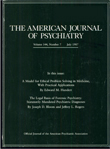A neuropsychological hypothesis explaining posttraumatic stress disorders
Abstract
The author reports findings from recent psychophysiological and biochemical research on Vietnam combat veterans with chronic posttraumatic stress disorder. Applying these data and the analogy of the known functional and structural defects in the peripheral (cranial) sensory system consequent to high-intensity stimulation, he hypothesizes that cortical neuronal and synaptic changes occur in posttraumatic stress disorder as the consequence of excessive and prolonged sensitizing stimulation leading to depression of habituating learning. He postulates that the "constant" symptoms of the disorder are due to the changes in the agonistic neuronal system which impair cortical control of hindbrain structures concerned with aggressive expression and the sleep-dream cycle.
Access content
To read the fulltext, please use one of the options below to sign in or purchase access.- Personal login
- Institutional Login
- Sign in via OpenAthens
- Register for access
-
Please login/register if you wish to pair your device and check access availability.
Not a subscriber?
PsychiatryOnline subscription options offer access to the DSM-5 library, books, journals, CME, and patient resources. This all-in-one virtual library provides psychiatrists and mental health professionals with key resources for diagnosis, treatment, research, and professional development.
Need more help? PsychiatryOnline Customer Service may be reached by emailing [email protected] or by calling 800-368-5777 (in the U.S.) or 703-907-7322 (outside the U.S.).



